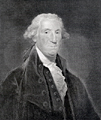 |

2. Face
|
 |


2. FACE
Symbolic:
 |
 |

Engraving of George Washington by Thomas Holloway after Gilbert Stuart used in Johann C. Lavater’s Essays on Physiognomy
National Portrait Gallery, Smithsonian Institution
|
Stuart, like many of his contemporaries, believed in physiognomy, the theory that a person’s appearance reflected temperament and character. Thus Stuart wanted to depict Washington so that his sterling character would be conveyed. An engraving of Stuart’s first portrait of Washington was used as an illustration for a book, Essays on Physiognomy. In the book, a writer comments that “every thing in this face announces the good man, a man upright, of simple manners, sincere, firm, reflecting and generous.”
 |
 |

George Washington, by James Peale, circa
1780-1786
The Warner Collection
of Gulf States
PaperCorporation,
Tuscaloosa, Alabama
|
A description of the Lansdowne painting in a London newspaper in 1797 observed that “The countenance is mild and yet forcible. The eye, of a light grey, is rendered marking by a brow to which physiognomy attaches the sign of power. The forehead is ample, the nose aquiline, the mouth regular and persuasive. The face is distinguishable for muscle rather than flesh, and this may be said of the whole person.”
 |
 |

George Washington by John Trumbull,
oil on canvas, 1792
Metropolitan Museum
of Art
|
Contemporaries who gazed upon Washington seemed to see more than a man. Descriptions of him bordered on mythical. His head, said an observer, was “well shaped . . . gracefully poised on a superb neck,” with “a large and straight” nose, “blue grey penetrating eyes,” high cheek bones, and a large mouth.
Biographic:
 |
 |

George Washington (Porthole portrait) by Rembrandt Peale, oil on canvas, circa 1823-1860
National Portrait Gallery, Smithsonian Institution. Gift of an anonymous donor
|
Abigail Adams, wife of John Adams, turned to the poetry of John Dryden to describe Washington: “He’s a temple Sacred by birth, and built by hands divine.” “Sacred, divine”—the words evoked the nation’s feelings about this man. They saw in his stern, yet engaging, face, reflections of inner virtues. It was a German-language newspaper that gave him his lasting title: Des Landes Vater, the Father of His Country.
 |
 |

George Washington by Rembrandt Peale, oil on canvas, circa 1853
National Portrait Gallery, Smithsonian Institution. Gift of an anonymous donor
|
An acquaintance once noted that Washington was “generally sedate and serious”—and “only after having two or three glasses of wine” plus some spirited conversation “does his face assume an expression of liveliness.” Abigail Adams said he “has a dignity which forbids familiarity mixed with an easy affability which creates love and reverence.”
 |
 |

George Washington by James Sharples, pastel on paper, circa 1795-1796
National Portrait Gallery, Smithsonian Institution
|
While many men in America wore wigs before the Revolutionary War, this practice began to go out of style after 1776. By the time Gilbert Stuart painted this portrait in 1796, Washington’s habit of powdering his own natural hair would have fit the fashion of the day. He tied his hair in a queue, which was sometimes worn in a small black silk bag.
 |
 |

Washington’s dentures, fitted with human teeth and modeled teeth carved from cow teeth and elephant ivory, circa 1790
Mount Vernon
Ladies’ Association
|
His painful, ill-fitting dentures made Washington’s mouth bulge out; he clamped his lips to hold them in. Supposedly he lost his teeth by cracking Brazil nuts between his jaws. By the time he became President, he had only one tooth left. One set of dentures was carved from hippopotamus tusk and had a space to accommodate the single tooth. This caused almost constant pain, which he tried to ease with laudanum.
Artistic:
After Stuart painted his first portrait of Washington, probably in 1794-95, Martha Washington asked to have her own portrait done, as well as another one of the President. Intended for Mount Vernon after Washington’s retirement, the portraits are known as the Athenaeum portraits because the Boston Athenaeum acquired them after Stuart’s death. In these portraits, Washington faces left, and Martha faces slightly to the right, so the pair would be balanced.
 |
 |
 |
 |

Life Mask of George Washington by Jean-Antoine Houdon, plaster, October 1785
The Pierpont Morgan Library, N.Y., USA
George Washington by Jean-Antoine Houdon, plaster bust, circa 1786
National Portrait Gallery, Smithsonian Institution
|
Stuart admired the sculpture of Washington by French artist Jean-Antoine Houdon, probably because it was based on a life mask and therefore extremely accurate. Stuart explained, “When I painted him, he had just had a set of false teeth inserted, which accounts for the constrained expression so noticeable about the mouth and lower part of the face. Houdon’s bust does not suffer from this defect. I wanted him as he looked at that time.” Stuart preferred the Athenaeum pose and, except for the gaze, used the same pose for the Lansdowne painting.
When Stuart began painting a portrait, he used muted tones of lights and darks, an “indistinct mass of light & shadows,” showing the subject “as seen in the heel of the evening, in the gray of the morning, or a distance too great to discriminate features with exactness.” In completing a portrait, he advised painters to “be bold and use the color freely, but let it be well mixed” with “no fuzzy edges, but liquid and all of one cast.”
 |
 |

George Washington (Athenaeum type) by Gilbert Stuart, oil on canvas, not dated
The Corcoran Gallery of Art, Washington, D.C.; William A. Clark Collection
|
Some critics claim that Stuart made Washington appear too stern. But the artist always said he painted what he saw: “Nature as Nature cannot be exceeded, and as your object is to copy Nature, twere the hight of folly to look at any thing else to produce that copy.”
|




